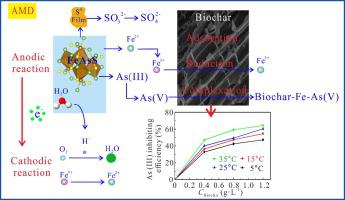Environment International ( IF 11.8 ) Pub Date : 2022-10-03 , DOI: 10.1016/j.envint.2022.107558 Ling Cen 1 , Hongguang Cheng 2 , Qingyou Liu 3 , Shuai Wang 1 , Xi Wang 4

|
Arsenopyrite (FeAsS) oxidative dissolution provides an important source for the occurrence of high arsenic in acid mine drainage (AMD). Biochar is a potent material that can dramatically sequestrate an array of heavy metals in water. However, little is known about the role of biochar on the fate of As from arsenopyrite in AMD. This study investigates the effects of biochar concentrations, AMD acidities, and temperatures on the release of As from arsenopyrite in a simulated AMD over a range of environmentally relevant conditions. Results show that biochar inhibits As release and further acidification without changing the arsenopyrite weathering mechanism. Arsenopyrite is first oxidized to Fe(II), As(III) and S0 and ultimately oxidized to Fe(III), As(V) and SO42-, respectively. Higher concentration, temperature or higher acidity promotes the arsenic release rate. Electrochemical studies showed that biochar inhibited As release and acidification for reduced the charge transfer resistance at the double layer and film resistance at the passivation layer, which was mainly attributed to Fe(III) ions in AMD being adsorbed, oxidized, and As complexed to biochar-Fe-As(V). This study reveals the release mechanism of As from arsenopyrite weathering in AMD and suggests the applicability of biochar in mitigating arsenic pollution and further acidification in sulfide mineral mine drainage.
中文翻译:

酸性矿山废水中砷黄铁矿风化释放的砷:动力学、转化和生物炭的影响
毒砂(FeAsS)氧化溶解为酸性矿山排水(AMD)中高砷的发生提供了重要来源。Biochar 是一种有效的材料,可以显着隔离水中的一系列重金属。然而,关于生物炭对 AMD 中毒砂中 As 命运的作用知之甚少。本研究调查了在一系列环境相关条件下,生物炭浓度、AMD 酸度和温度对模拟 AMD 中毒砂释放 As 的影响。结果表明,生物炭在不改变毒砂风化机制的情况下抑制砷释放和进一步酸化。毒砂首先被氧化为 Fe(II)、As(III) 和 S 0,最终被氧化为 Fe(III)、As(V) 和 SO 4 2-, 分别。较高的浓度、温度或较高的酸度会促进砷的释放速率。电化学研究表明,生物炭抑制 As 释放和酸化,降低双电层电荷转移电阻和钝化层膜电阻,这主要是由于 AMD 中的 Fe(III) 离子被吸附、氧化和 As 与生物炭络合-Fe-As(V)。本研究揭示了 AMD 中砷黄铁矿风化释放 As 的机制,并表明生物炭在减轻砷污染和进一步酸化硫化物矿山排水方面的适用性。



























 京公网安备 11010802027423号
京公网安备 11010802027423号